 W
WA screw and a bolt are similar types of fastener typically made of metal and characterized by a helical ridge, called a male thread. Screws and bolts are used to fasten materials by the engagement of the screw thread with a similar female thread in the matching part.
 W
WAnchor bolts are used to connect structural and non-structural elements to concrete. The connection can be made by a variety of different components: anchor bolts, steel plates, or stiffeners. Anchor bolts transfer different types of load: tension forces and shear forces.
 W
WAn Archimedes' screw, also known as the water screw, screw pump or Egyptian screw, is a machine used for transferring water from a low-lying body of water into irrigation ditches. Water is pumped by turning a screw-shaped surface inside a pipe. It is named after Greek philosopher Archimedes who first described it around 234 BC, although there is evidence that the device had been used in Ancient Egypt long before his time. A screw conveyor is a similar device which transports bulk materials such as powders and grains. Archimedes screws can be also used to generate power if they are driven by flowing fluid instead of lifting fluid. Archimedes Screw Turbine/Generator (AST/ASG) is a new form of small and micro hydropower technology that can be applied even in low head sites.
 W
WIn mechanical engineering, backlash, sometimes called lash, play, or slop, is a clearance or lost motion in a mechanism caused by gaps between the parts. It can be defined as "the maximum distance or angle through which any part of a mechanical system may be moved in one direction without applying appreciable force or motion to the next part in mechanical sequence."p. 1-8 An example, in the context of gears and gear trains, is the amount of clearance between mated gear teeth. It can be seen when the direction of movement is reversed and the slack or lost motion is taken up before the reversal of motion is complete. It can be heard from the railway couplings when a train reverses direction. Another example is in a valve train with mechanical tappets, where a certain range of lash is necessary for the valves to work properly.
 W
WA ball screw is a mechanical linear actuator that translates rotational motion to linear motion with little friction. A threaded shaft provides a helical raceway for ball bearings which act as a precision screw. As well as being able to apply or withstand high thrust loads, they can do so with minimum internal friction. They are made to close tolerances and are therefore suitable for use in situations in which high precision is necessary. The ball assembly acts as the nut while the threaded shaft is the screw. In contrast to conventional leadscrews, ballscrews tend to be rather bulky, due to the need to have a mechanism to re-circulate the balls.
 W
WThe Berry Brothers Bolt Works is a former factory in Columbus, Ohio, United States. For more than a century after its 1888 construction, the factory produced machine tools using original equipment. The structure itself is one of Columbus' most prominent factory buildings, and it was named a historic site in its centennial year.
 W
WA bolt is a form of threaded fastener with an external male thread requiring a matching pre-formed female thread such as a nut. Bolts are very closely related to screws.
 W
WThe buttress thread form refers to two different thread profiles:One is a type of leadscrew often used in machinery, and is also known as the sawtooth thread or breech-lock thread form. The asymmetric thread form allows the thread to have low friction and withstand greater loads than other forms in one direction, but at the cost of higher friction and inferior load bearing in the opposite direction.The other is a type of trapezoidal (ACME) tapered pipe thread, also known as the buttress pipe thread. It is often used in oil fields as a hydraulic sealing thread form.
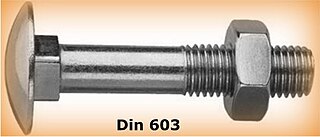 W
WA carriage bolt (also called coach bolt and round-head square-neck bolt is a form of bolt used to fasten metal to metal or, more commonly, wood to metal. Also known as a cup head bolt in Australia and New Zealand.
 W
WA carriage bolt (also called coach bolt and round-head square-neck bolt is a form of bolt used to fasten metal to metal or, more commonly, wood to metal. Also known as a cup head bolt in Australia and New Zealand.
 W
WComputer case screws are the hardware used to secure parts of a PC to the case. Although there are numerous manufacturers of computer cases, they have generally used three thread sizes. The Unified Thread Standard (UTS) originates from the United States, while the ISO metric screw thread is standardized worldwide. In turn, these thread standards define preferred size combinations that are based on generic units—some on the inch and others on the millimetre.
 W
WA differential screw is a mechanism used for making small, precise adjustments to the spacing between two objects. A differential screw uses a spindle with two screw threads of differing leads, and possibly opposite handedness, on which two nuts move. As the spindle rotates, the space between the nuts changes based on the difference between the threads. These mechanisms allow extremely small adjustments using commonly available screws. A differential screw mechanism using two nuts incurs higher friction and therefore requires more torque to turn than a simple, single lead screw with an equivalent pitch.
 W
WA "Dimpler", also known as a drywall screw setter, is a #2 Phillips screwdriver tip usually 1 inch (25 mm) long with a stopper. It is used to stop the drywall screw from penetrating the drywall.
 W
WThe term fine adjustment screw typically refers to screws with threads from 40 to 100 TPI and ultra fine adjustment screw has been used to refer to 100–508 TPI. Even though these are non-standard threads, both ISO metric screw thread designations and UNC designations have been used to call out thread dimensions and fit (class). A typical use for a fine adjustment screw is in an optical mirror mount as an adjuster. Typically 80 TPI screws are used in mirror mounts. Ultra fine adjuster screws are used in applications requiring extremely fine motion like laser alignment, fiber coupling.
 W
WIn mechanical engineering, a helix angle is the angle between any helix and an axial line on its right, circular cylinder or cone. Common applications are screws, helical gears, and worm gears.
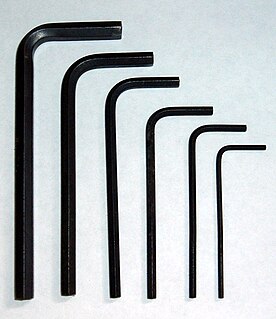 W
WA hex key is a simple driver for screws that have heads with internal hexagonal recesses (sockets).
 W
WAn interrupted screw or interrupted thread is a mechanical device typically used in the breech of artillery guns. It is believed to have been invented in 1845.
 W
WA jackscrew, or screw jack, is a type of jack that is operated by turning a leadscrew. It is commonly used to lift moderately and heavy weights, such as vehicles; to raise and lower the horizontal stabilizers of aircraft; and as adjustable supports for heavy loads, such as the foundations of houses.
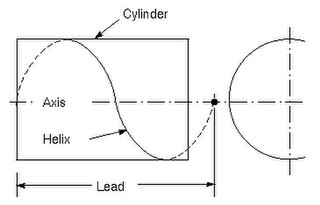 W
WLead is the axial advance of a helix or screw during one complete turn (360°) The lead for a screw thread is the axial travel for a single revolution.
 W
WA leadscrew, also known as a power screw or translation screw, is a screw used as a linkage in a machine, to translate turning motion into linear motion. Because of the large area of sliding contact between their male and female members, screw threads have larger frictional energy losses compared to other linkages. They are not typically used to carry high power, but more for intermittent use in low power actuator and positioner mechanisms. Leadscrews are commonly used in linear actuators, machine slides, vises, presses, and jacks. Leadscrews are a common component in electric linear actuators.
 W
WA nut is a type of fastener with a threaded hole. Nuts are almost always used in conjunction with a mating bolt to fasten multiple parts together. The two partners are kept together by a combination of their threads' friction, a slight stretching of the bolt, and compression of the parts to be held together.
 W
WJohn Penn (1805–1878) was an English marine engineer whose firm was pre-eminent in the middle of the 19th century due to his innovations in engine and propeller systems, which led his firm to be the major supplier to the Royal Navy as it made the transition from sail to steam power. He was also president of the Institution of Mechanical Engineers on two occasions.
 W
WThe pentalobe security screw, or pentalobe screw drive, is a five-pointed tamper-resistant system used by, but not limited to, Apple in their products. Pentalobe screws were adopted by Apple starting in 2009, when they were first implemented in the 15-inch MacBook Pro. They have since been used on other MacBook Pro, MacBook Air and iPhone models. Apple attracted criticism upon the introduction of the pentalobe screw; it was seen by some as an attempt to lock individuals out of their devices. In response, inexpensive pentalobe screwdrivers, manufactured by third parties, have become relatively easy to obtain.
 W
WA pentalobular screw thread is a form of self-forming thread used for screws. Self-forming screws are used in ductile materials, such as aluminium and plastics.
 W
WHenry Frank Phillips was an American businessman from Portland, Oregon. The Phillips-head ("crosshead") screw and screwdriver are named after him.
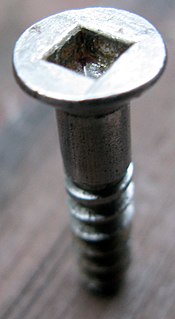 W
WA Robertson screw, also known as a square screw or Scrulox, is a type of screw which has a square-shaped socket in the screw head and a square protrusion on the tool. Both the tool and the socket have a slight taper. Originally to make the manufacture of the screws practical using cold forming of the heads, this taper provides two other advantages which have served to popularize the drive: it makes inserting the tool easier, and tends to help keep the screw on the tool tip without the user needing to hold it there. The Robertson screw is specified as ANSI Type III Square Center.
 W
WPeter Lymburner Robertson was a Canadian inventor, industrialist, salesman, and philanthropist who popularized the square-socket drive for screws, often called the Robertson drive. Although a square-socket drive had been conceived decades before, it had never been developed into a commercial success because the design was difficult to manufacture. Robertson's efficient manufacturing technique using cold forming for the screw's head is what made the idea a commercial success. He produced his screws in his Milton, Ontario, factory starting in 1908. The brand has been sold over the years, and the manufacturing for the present corporation is done in Jiaxing, Zhejiang, China; but the Milton, Ontario, building was still a head office for a long time before moving to nearby Burlington, Ontario.
 W
WA roller screw, also known as a planetary roller screw or satellite roller screw, is a low-friction precision screw-type actuator, a mechanical device for converting rotational motion to linear motion, or vice versa. Planetary roller screws are used as the actuating mechanism in many electro-mechanical linear actuators. Due to its complexity the roller screw is a relatively expensive actuator, but may be suitable for high-precision, high-speed, heavy-load, long-life and heavy-use applications.
 W
WA screw extractor is a tool for removing broken or seized screws. There are two types: one has a spiral flute structure, commonly called an easy out after the trademarked name EZ-Out; the other has a straight flute structure. Screw extractors are intentionally made of hard, brittle steel, and, if too much torque is applied, can break off inside the screw that is being removed. Since the extractor is an extremely hard material, and a typical home shop drill bit will not be able to drill into it, a larger element of difficulty is added to the original screw extraction project. One way to avoid this added difficulty is to drill a hole completely through the screw. Thus, if the fastener breaks, a punch can be used to drive out the easy out from the screw, via the back, or end, of the fastener.
 W
WA screw pump, also known as a water screw, is a positive-displacement (PD) pump that use one or several screws to move fluid solids or liquids along the screw(s) axis. In its simplest form, a single screw rotates in a cylindrical cavity, thereby moving the material along the screw's spindle. This ancient construction is still used in many low-tech applications, such as irrigation systems and in agricultural machinery for transporting grain and other solids.
 W
WA screw thread, often shortened to thread, is a helical structure used to convert between rotational and linear movement or force. A screw thread is a ridge wrapped around a cylinder or cone in the form of a helix, with the former being called a straight thread and the latter called a tapered thread. A screw thread is the essential feature of the screw as a simple machine and also as a threaded fastener.
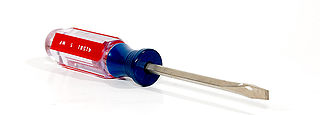 W
WA screwdriver is a tool, manual or powered, used for driving screws. A typical simple screwdriver has a handle and a shaft, ending in a tip the user puts into the screw head before turning the handle. This form of the screwdriver has been replaced in many workplaces and homes with a more modern and versatile tool, a power drill, as they are quicker, easier, and also can drill holes. The shaft is usually made of tough steel to resist bending or twisting. The tip may be hardened to resist wear, treated with a dark tip coating for improved visual contrast between tip and screw—or ridged or treated for additional 'grip'. Handles are typically wood, metal, or plastic and usually hexagonal, square, or oval in cross-section to improve grip and prevent the tool from rolling when set down. Some manual screwdrivers have interchangeable tips that fit into a socket on the end of the shaft and are held in mechanically or magnetically. These often have a hollow handle that contains various types and sizes of tips, and a reversible ratchet action that allows multiple full turns without repositioning the tip or the user's hand.
 W
WA self-tapping screw is a screw that can tap its own hole as it is driven into the material. More narrowly, self-tapping is used only to describe a specific type of thread-cutting screw intended to produce a thread in relatively soft material or sheet materials, excluding wood screws. Other specific types of self-tapping screw include self-drilling screws and thread rolling screws.
 W
WA self-tapping screw is a screw that can tap its own hole as it is driven into the material. More narrowly, self-tapping is used only to describe a specific type of thread-cutting screw intended to produce a thread in relatively soft material or sheet materials, excluding wood screws. Other specific types of self-tapping screw include self-drilling screws and thread rolling screws.
 W
WA set screw, also known as a blind screw or a grub screw, is a type of screw generally used as a detent to secure an object within or against another object, usually without using a nut. The most common examples are securing a pulley or gear to a shaft. Set screws are usually headless, meaning that the screw is fully threaded and has no head projecting past the thread's major diameter. If a set screw does have a head, the thread will extend all the way to the head. A set screw is almost always driven with an internal-wrenching drive, such as a hex socket (Allen), star (Torx), square socket (Robertson), or a slot. The set screw passes through a threaded hole in the outer object and is tightened against the inner object to prevent it from moving relative to the outer object. It exerts compressional or clamping force through the bottom tip that projects through the hole.
 W
WThe square thread form is a common screw thread form, used in high load applications such as leadscrews and jackscrews. It gets its name from the square cross-section of the thread. It is the lowest friction and most efficient thread form, but it is difficult to fabricate.
 W
WThe thread angle of a screw is the included angle between the thread flanks, measured in a plane containing the thread axis. This is a defining factor for the shape of a screw thread. Standard values include:
 W
WThread-locking fluid or threadlocker is a thin, single-component adhesive, applied to the threads of fasteners such as screws and bolts to prevent loosening, leakage, and corrosion.
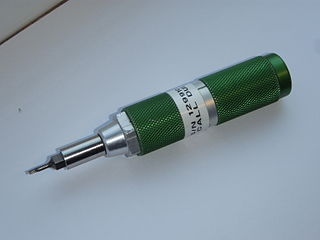 W
WA torque screwdriver is a screwdriver with components that ensure tightening to a specified torque, ensuring tightening which is sufficient, but not excessive. An insufficiently tightened screw connection may loosen in operation, and excessive tightening can damage parts; for example, if the nuts holding the wheel of a car in place are too loose, or damaged by overtightening, a wheel may come off at speed. Torque screwdrivers are used in mechanical production, manufacturing, and maintenance; their use is part of quality assurance.
 W
WTorx is a trademark for a type of screw drive characterized by a 6-point star-shaped pattern, developed in 1967 by Camcar Textron. A popular generic name for the drive is star, as in star screwdriver or star bits. The official generic name, standardized by the International Organization for Standardization as ISO 10664, is hexalobular internal. This is sometimes abbreviated in databases and catalogs as 6lobe. Torx Plus, Torx Paralobe and Torx ttap are improved head profiles.
 W
WTrapezoidal thread forms are screw thread profiles with trapezoidal outlines. They are the most common forms used for leadscrews. They offer high strength and ease of manufacture. They are typically found where large loads are required, as in a vise or the leadscrew of a lathe. Standardized variations include multiple-start threads, left-hand threads, and self-centering threads.
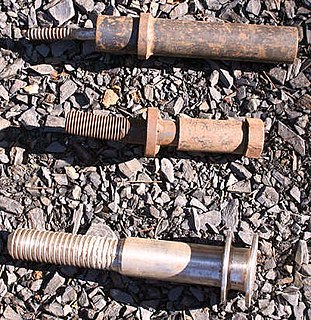 W
WTreehouse attachment bolts or TABs are specialized bolts engineered for treehouse construction. Various models and trademarks exist, with names such as Garnier limbs (GLs); tree anchor bolts; artificial limbs; heavy limbs or hyper limbs (HLs); special tree fastener or stud tree fastener (STFs).
 W
WA U-bolt is a bolt in the shape of the letter U with screw threads on both ends.
 W
WA screw and a bolt are similar types of fastener typically made of metal and characterized by a helical ridge, called a male thread. Screws and bolts are used to fasten materials by the engagement of the screw thread with a similar female thread in the matching part.
 W
WWidth across flats is the distance between two parallel surfaces on the head of a screw or bolt, or a nut, mostly for torque transmission by positive locking.
 W
WThe trade name "Yankee" screwdriver was first marketed by North Brothers Manufacturing Company in ≈16 April 1895, with the No. ≠130 spiral ratchet screwdriver. Yankee soon became and still is a well-known name in automatic spiral ratchet screwdrivers, with several other models, and model improvements patented by North Bros. over a 40-year period.